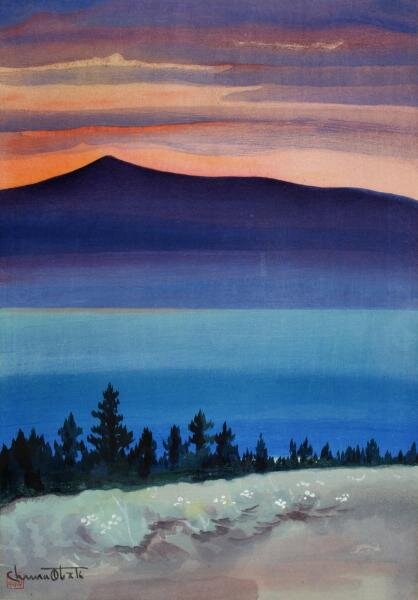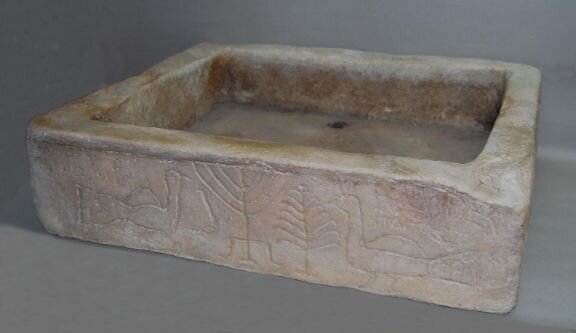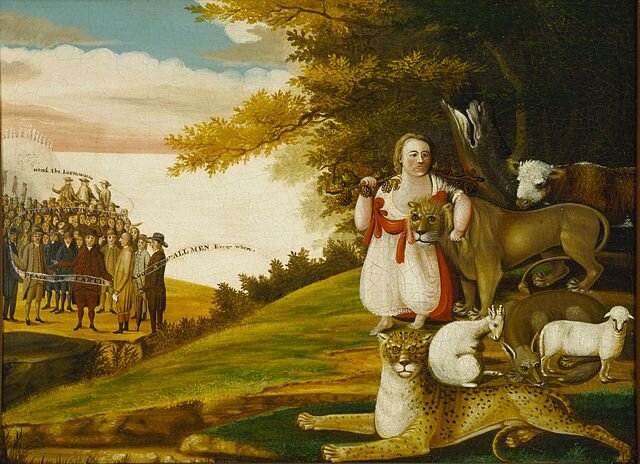Caspar David Friedrich, a German romantic painter, used landscapes symbolically to express concepts about faith, life, death, salvation. In this image of snow-capped mountains in the Bavarian Alps, The Watzmann (1824-1825), reach up to the heavens generating a different quality of life than in the foreground and middle ground. The compositional balance, lack of movement, and deliberate application of color in fine brushstrokes provide a meditative quality that is quite different than the context of uprising and agitation in the wake of the Napoleonic invasions.
Caspar David Friedrich, The Watzmann, 1824-1825. Oil on canvas. Alte Nationalgalerie, Berlin. Google Arts and Culture.
Chiura Obata. Evening Glow at Mono Lake, from Mono Mills, 1930. Color woodcut on paper.
I knew nothing about this artist until Bill and I saw the exhibition at New Years at the Museum of American Art in Washington, D.C. The exhibition exuded tranquility in the scope of this artist’s images and their integration of traditional Japanese composition and aesthetics with American landscape and experience. In terms of the theme of “Peace be with You” several brainstormed terms come to the foreground: stillness, tranquility, meditation, harmony, resonance. Reading this painting through a biographical lens, however, demonstrates that this depicts more than a physical environment of peace. As a Japanese American, Obata was a stranger on these shores. His family would in the next decade be interred in the concentration camps. The quite of the landscape here anticipates both crisis and opportunity.
Trilingual Sephardic Basin. 5th century. White marble. Museo Sefardi. https://g.co/arts/RBBsm1cWYs3GHEzH7
The “trilingual basin” is so named because of the texts in Latin, Greek and Hebrew. These languages likely reference the language of power and politics at the time the pool was made, Latin; Greek served as the language of scholars in the Hellenistic world and the language in which Paul wrote his letters that are part of the Christian New Testament. The Hebrew identifies the object as relating to the Sephardic community of Spain dating from the Roman destruction of the Jerusalem temple in 70 CE and leading to the Diaspora and subsequent establishment of communities and synagogues in many lands of the Mediterranean world. According to the Museo Sefardi, the texts translate from the “Hebrew: ‘Peace over Israel and over us and over our children’." Latin: ´Peace´ and in Greek it is illegible. Adorned with symbols used in the iconography of the time (ca. V century): two peacocks, a sofar [sic] or penitential horn, some also see a snake, the tree of life and a seven-armed candelabra or ‘menorah’.” Most scholars date this to early in the 5th century. By the time of Visigoth domination of Spain in the 7th century, the prayer for peace for Israel, the worshippers and their progeny seems sadly ominous. In 636, Bishop Julian of Toledo decreed that the “cancer” of the Jews needed to be wiped out.[1] Many scholars agree that the period of Visigoth rule that lasted until the Muslim Umayyad conquest of Hispania after 711 was characterized by some the worst persecutions, greatest violence and most severe restrictions.
[1] Jeffrey Gorsky, “The Visigoth Persecution of the Jews,” Exiles in Sepharad: The Jewish Millenium in Spain (Lincoln: University of Nebraska Press, 2015), 14. http://www.jstor.com/stable/j.ctt1d989dp.9.
Brasilian artist Clovis Graciano, one of a group of young activist modernist artists in Brasil in the 1930s, painted this figure who engages the viewer and clasps a brightly lit dove, the symbol of peace during a time of escalating crisis two years after the military seized power. Graciano was a radical, and activist for social justice. 1966 was a year of student protests violently suppressed by the military dictatorship. Despite a negotiated truce with the government in July of 1966, “in a raid in September 1966, the military police arrested 178 students.”[1]
[1] Brown University: Center for Digital Scholarship, “The Rise of Student Movements,” Brazil: Five Centuries of Change by Thomas E. Skidmore, 2nd edition, companion website (Oxford: Oxford University Press, 2010), https://library.brown.edu/create/fivecenturiesofchange/chapters/chapter-7/student-movement/accessed 22 June 2020.
Clovis Graciano, Untitled. 1966. Oil on canvas. https://g.co/arts/3bPPDLBiJ62uSUzM6
Bucks County artist Edward Hicks practiced both sign painting and worked as an itinerant Quaker preacher. He painted dozens of this popular image with subtle variations in content and imagery. This particular version has several interesting features. The imagery comes from Isaiah’s prophetic descriptions of a New Jerusalem,
The wolf and the lamb shall feed together,
the lion shall eat straw like the ox;
but the serpent—its food shall be dust!
They shall not hurt or destroy
on all my holy mountain, says the Lord (Isaiah 17:25)
and
The wolf shall live with the lamb,
the leopard shall lie down with the kid,
the calf and the lion and the fatling together,
and a little child shall lead them (Isaiah 11: 6-7).
Although the Philadelphia Museum of Art version depicts this New Jerusalem in the context of William Penn’s Quaker experiment, the one below has a more generalized set of texts related to Quaker teaching: pacifism, inner light, equality before God and includes a sketchy section on the left side that looks like faithful who have moved from this kingdom to a heavenly one. For more on the Philadelphia version, you might be interested in this Smart History segment with Barbara Bassett, Philadelphia Museum of Art and Dr. Beth Harris, Khan Academy: Barbara Bassett, Philadelphia Museum of Art and Dr. Beth Harris, "The Peaceable Kingdom as Penn’s parable," in Smarthistory, February 3, 2019, accessed June 23, 2020, https://smarthistory.org/seeing-america-2/hicks-peaceable-kingdom-2/.
Edward Hicks. A Peaceable Kingdom with Quakers Bearing Banners. 1829-1830. Terra Foundation.
My homework “symbol, image or piece of music” was Morten Lauridsen’s Lux Aeterna, the movement, “O Nata Lux.” Here is a link to the recording that I shared from YouTube! VOCES 8




